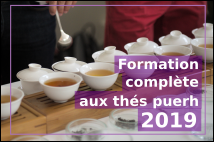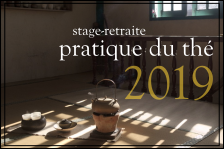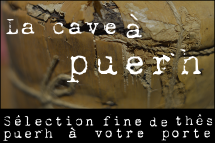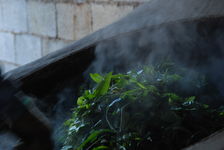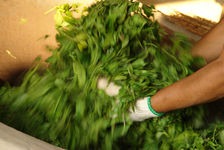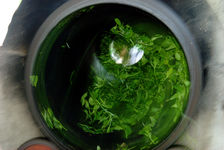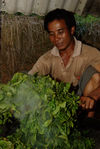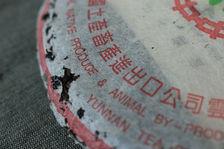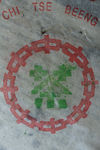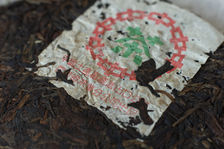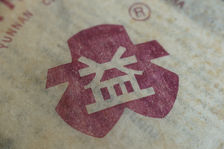 This page is not a real translation but just an automatic translation generated by computer of the original article, written in French language! Its not good... but better than nothing!
This page is not a real translation but just an automatic translation generated by computer of the original article, written in French language! Its not good... but better than nothing!Want to help us do diffuse puerh tea culture in english, by providing a better (or corrected) translation?
Please contact us!

Whether it is to meet its own consumption today for years to come, or for future decades to bequeath to his children or grandchildren , or to resell and make a profit , the tea lover puerh (Pu Er tea) are often simply not consume and enjoy their favorite teas, but generally has a small cellar and also stores teas for future days.


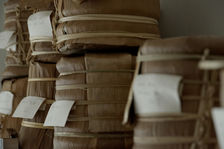

- 1.Flip puerh (Pu Er tea) on a shelf
- 2.Jian puerh (Pu Er tea) stored for the future
- 3.Flip puerh (Pu Er tea) in a personal cellar
- 4. patties puerh (Pu Er tea) stored in bamboo boxes for long term
I had already discussed in a previous article on strategies storage different reasons and benefits storage , and I 'd like to explore today with a question that naturally arises any amateur puerh:how and why tea store store as tea rather than another?
Young puerh (Pu Er tea) , puerh (Pu Er tea) aged , antique puerh (Pu Er tea) , issues radically different
Although it stores both young puerh (Pu Er tea) puerh that older , and it is also wise to set aside teas of year old slabs , approach and motivations of storage are quite different between these families puerh (Pu Er tea) .
Teas older:store at a good price as they allow
The value of puerh (Pu Er tea) older increases from year to year , whether teas few years or antique tea over 50 years. The price of these now rare and very expensive, following the market demand , particularly following auctions . The value of teas few years to several decades , except sudden infatuation for a particular great tea , increase its share to more regularly , usually between 10% and 50 % per year.
Amateur old puerh (Pu Er tea) and has an interest in the store faster such relatively aged teas, whose value will continue to increase and will be more expensive to purchase in the coming years . For example , if there's still a few years it was great vintage 90s for only a few hundred dollars , many of these teas today (2014) surpassed the 1,000 euros wafer , which deters some amateurs.


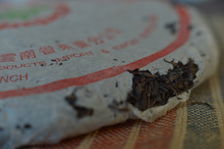
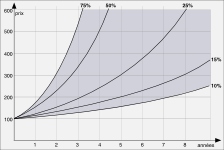
- 1.Cakes puerh (Pu Er tea) 90s
- 2.Lan Shui Yin big slab of 90
- 3.Slab 90s
- 4.Examples of price increase of puerh (Pu Er tea) in time according to their rating
Similarly references recognized 2000s, as good 7542 in the early 2000s from quality dry natural storage , follow the same curve , and if these teas are still affordable today , the amateur will soon pay more to offer these teas. It is good to remember that tea whose prices are rising annually by a given proportion and fixed 25 % of its price for example, does not see its price increase linearly , but more rapidly . A cake only 100 euros today , and whose grime price of 25 % per year, and cost and in only 5 years more than 300 euros. Tea today at 100 euros undergoing an annual increase of only 10% for its part will double its value in less than 8 years , and only 5 years with annual growth of 15%.
Often can store as many teas he would like the amateur puerh (Pu Er tea) so take care to choose a priority teas subject to annual increase , others can wait a few more years. Among these teas whose prices are rising particularly rapidly appear first places teas produced before the 90s , the price is already high and tend to rise more quickly .
In the field of younger teas produced between the early 90s and the late 2000s, amateur desiring to buy now and choose the best prices in prime locations raw puerh (Pu Er tea) recognized producer as Menghai Tea Factory or XiaGuan , assemblies recognized as 7542 8582 , as well as series and vintages recognized amateurs such as for example and among many other the < b> Shui Lan Yin 1997 Brand orange 1996 " Bud Yi Wu " 1992 or authentic 88 qing bing in the early 90s , with the increase particularly fast (often well beyond 25 % per annum) may dissuade quickly purchase.
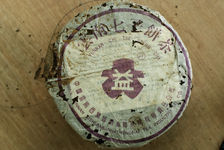
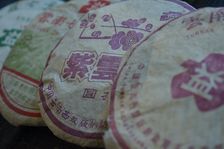
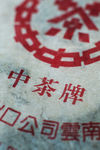
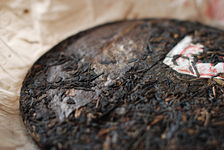
- 1.Da Yi 7542 2004
- 2.Pancakes known 2000s
- 3.Rare wafer CNNP Mengku the early 2000s
- 4.Galette wild tea plants Mengku 2005
In a second time , it also makes sense to invest in quality teas produced by producers less desirable for collectors and enthusiasts , as Mengku Rong Shi , < b> Fengqing Cha Chang Changtai Hao , or productions CNNP from undetermined plants ( Nei Fei stamped CNNP in Menghai Tea Factory locations or other identifiable plant ) , the value without the tremendous growth of large listed teas, still increases every year consistently . This is especially the case of some large slabs of these producers, such as Mu Shu Cha first (2005 ) and second ( 2006) edition, or the first editions of Lao Banzhang Chen Sheng Hao whose prices have also reached the top in a handful of years only.
Young teas:tea store as they become available
The purchase problematic teas under 10 years is quite different from that of the oldest teas. As discussed in a previous article , storage young teas has indeed many advantages, including allowing access to a wider variety of teas at great prices , and limit counterfeits.
But if the value of older teas tend to climb , young teas for their part, tend to disappear from the stalls of vendors pushing the amateur to buy either before it would be too expensive but before they are simply more available for sale .
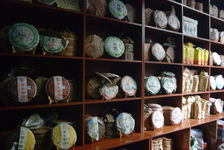
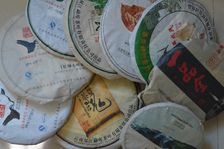

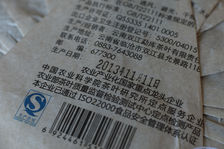
- 1.Multitude of young puerh (Pu Er tea) shop in Yunnan
- 2.Catalogue Rong Shi 2013
- 3.Shopping in a market puerh (Pu Er tea) tea
- 4.Slab of the Year
Each year is indeed produced in Yunnan tens of thousands of tons of puerh (Pu Er tea) teas , some of which can be found on the shelves of tea houses . Gold in Yunnan, but also elsewhere, young puerh (Pu Er tea) tea is consumed and a large part of production are consumed in the year of production , or in the next few years . In addition, after the crack puerh (Pu Er tea) market experienced in 2008, the world 's largest in Yunnan ventures to store puerh (Pu Er tea) , and wholesalers are now so annually to liquidate their stocks before re- storing productions following , and thus keep more as was the case a few years there's stock in past years.
The retailer, who usually buy limited stocks last productions , so are now more often able to re- store the recent references once they run out, and these simply disappear from their card. So if it is now easy to find teas year or last year , or otherwise teas more than 10 years , it is often much more difficult to find good references older from May to October years , and it will be even harder to find good productions this year in only 2 or 3 years. Some popular productions , having distinguished themselves in such a contest, can even now disappear in a few months.
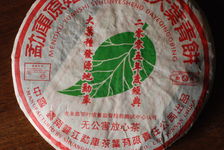

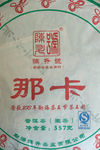
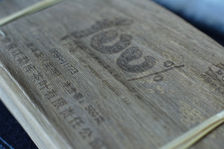
- 1.Example of good galette 2005
- 2.recognized Galette 2012
- 3.Na Ka Chen Sheng puerh (Pu Er tea) noticed a large 2013
- 4.100 percent Mengku a major puerh (Pu Er tea) noticed 2013
Amateur puerh (Pu Er tea) teas youth seeking store for years to come, so take care before any disappearance, sometimes fast and sudden , teas he covets . It is therefore in prime locations to store teas from before 2008 , often still available but including stock based visibly and whose scarcity is watching . But also teas of the year , building in prime locations on tea lovers noticed , as for example this year in 2013 Chen Sheng Ka Na or Mengku Rong Shi 100% will first to disappear .
But the bold and clever amateur looking good for the future teas usually take care to store as quality teas produced by little known producers . Indeed a number of large tea producers or great references puerh (Pu Er tea) tea that we would have missed them summers stored by investors or teahouses practicing maturation , especially in Dong Guan, Hong Kong and Taiwan, and will likely reappear on the market within a year tens . Teas against less known producers, does not provide for a satisfactory annual increase investor in old tea, and will most likely be found by totally can , while some of them have an excellent potential to maturation .
special case of ancient teas:teas disappearing market to buy as soon as possible ... if we can
For the wealthy finally, among the ancient teas teas set aside as a priority, the risk of not being able to do so in the years to come. Although radically different youth peurh , antique tea produced before the 50s indeed share something in common with very young puerh (Pu Er tea) quality:their impending exit from the market .
Antique tea or Hao Ji Cha, produced before 1949 are indeed a particularly exciting field of puerh (Pu Er tea) teas . Remarkably expensive ( usually more than 15,000 euros glaette ), the value of these teas now growing very rapidly , making these teas less economically accessible .
But even more worrying , it is becoming increasingly difficult to find these teas , because of their rarity, but also their output more and fastest ancient teas, and various major references in the history of puerh (Pu Er tea) tea are now virtually unobtainable .
The big ancient teas were indeed in the year 90 in stock houses teas Hong Kongaises . At the opening of these sticks, these teas were left in the hands of a few tea houses and collectors Hong Kongers and Taiwanese. Regularly, when the coast was in favor of these teas , some of these collections came and appeared on the market. Bought by amateurs, these teas were also commonly bought by other investors or tea houses from the middle of tea to be sold later expensive a few years , and continuously supplying the market of old teas.
This situation has however changed significantly in recent years with the arrival on the market of buyers came from mainland China. The new easy and wealthy class in China , headed by a multitude of new millionaires and billionaires created by the opening of China today is a privileged clientele in many areas, including luxury, and are today ' Today the first buyers of antique puerh (Pu Er tea) .
Faced with this customer who does not look at the expense , many stocks antique puerh (Pu Er tea) already returned to the mainland from Hong Kong , Taiwan and Malaysia , and ancient tea still in circulation on the market are becoming rarer.
But the difference between these new buyers, large industrial , businessman , real estate fortunes or fashionable artists , collectors compared to the mid tea makers and they tend to see the purchase of such exorbitant teas a hobby VIP , a little caprice trend, or a simple way to spend money . Where puerh (Pu Er tea) acquired by the older generation of collectors or investors returning one day or the other on the market , teas acquired by the new wealthy Chinese customers are likely never to return to the market, but of being drunk or finish decorating in a window or a bank vault , therefore depleting drastically the current offer antique tea.
It is for the amateur who can afford the time to invest in this kind of masterpiece of the past, before they are literally go out of scope .
The quality tea, the decisive criterion
Just as no one would think I think , except by pure experimentation, purchase quantity of table wine cubix first prize for storing a few decades , it is not to lose time , money and space , storing teas poor quality , and a focus on storage quality teas .
Nothing is more regrettable than having spent years storing a collection of cakes with care , patience, and hope to finally realize that they barely worth the trouble of being drunk .
But the quality of tea is above all the quality of the material, ie the leaf and the tree that bore him , but also the quality of work fresh leaves to tea cake .
Origin and capital of the sheet, the first condition of maturation
Proper maturation of the tea is due to the action of living microorganisms and enzymes to the surface of the tea leaves . It is these organisms and enzymes that will degrade they produce different compounds present in the leaves of puerh (Pu Er tea) , and transform aromatic components.
It is therefore necessary to ensure proper processing of the sheet the latter is rich , first of live microorganisms , so that work within the proper maturation of the tea , but also in order to create various compounds and maintain a favorable context for the work of the organization . Finally, the sheet should have a good capital , ie be rich in elements ready to be transformed over time , and which support the work of micro -organisms and enzymes.
This will avoid teas too cheap (especially if they come from areas that they are not cheap ), or teas from shrubs planted terrace (Tai Di ) or other forms of intensive production . Be preferred instead to store teas from real trees ( Qiao Mu) , so with a trunk and a top, and even better old trees (Gu Shu ), these latter producing a wealth , including secondary metabolites that young bushes do not produce, and on which maturation can rely .
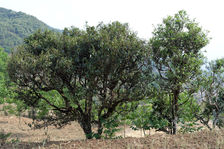


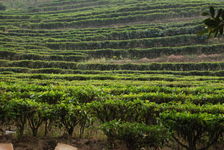
- 1.Gu Shu Cha in Lincang
- 2.Example of a garden built in the forest
- 3.Landscape of intensive culture Da Du Gang
- 4.Intensive Culture
Similarly , in order to maximize the wealth of leaves and their compounds teas from natural environments and healthy is preferred (Shen Tai ), ideally with a good < b> natural biodiversity , and preferably avoided teas from chemically or terrace cultivation treaties.
This is particularly important in the case of a personal wine cellar, or more generally a natural atmosphere storage , especially in a dry area . If indeed teas large industrial productions 80 or 90 have given excellent results , leaving some to believe that the amateur arrive at similar results by storing this type of tea today , it is good to remember that these older teas are generally derived from controlled , Hong Kong or elsewhere storage , and needs to achieve this high added water ( in vapor form , for example) to promote maturation and bearing lacks the richness of the initial sheet . If so these teas intensive production can sometimes suit quality controlled in a humid atmosphere ripening , they do not generally have the potential for good ripening " at home ", for which we therefore prefer mature or old trees .
Qualtié work sheets , including Sha Qing (see From the tree to the cake ) also are crucial and determines the future maturation. The purpose of Sha Qing is indeed partially drying the sheets and to inhibit the action of certain enzymes present in the leaf surface in order to avoid oxidation during drying.
But do not sterilize sheets provided , making the post- fermentation tea impossible. To allow for future maturation desiccation of the leaves should retain some moisture and a number of live microorganisms. A Sha Qing inadequate and will affect the maturation potential of tea. Too low it will cause unwanted during drying leaves fermentation. Too high it can damage the agencies responsible for future fermentation puerh (Pu Er tea) and limit its potential for maturation.
We also prefer a priori teas from assemblies , whether trees, gardens, grading or seasons , allowing a greater diversity of constituents and organizations that teas of origin and single harvest .
special case of wild tea tree
Puerh teas produced from genuine wild tea plants , not trees domesticated whatever their age varieties , have by their nature and composition of a particular potential for maturation .
This maturation is not only faster than a regular puerh (Pu Er tea) , but also develops aromas of its own .
Sometimes characterized in the early years with the keys citrus or lemon , wild puerh (Pu Er tea) tea plants gradually lose these youthful aromas to develop Empyreumatic characteristic dimension , which may suggest smoked and develop over the years years woody notes , which is generally more crosses puerh (Pu Er tea) in over 20 years .
These "wild" puerh (Pu Er tea) that you can enjoy at any age are , when they are quality , perfectly suited to a storage medium and long term . Preference will be given to it teas from mature trees , and with a good proportion of large leaves. Large wild buds, cheaper than wild leaves and sometimes found assembled together , it indeed a different property to the maturation and tend to misrepresent the character of the wild leaf .
If so the quality and potential of the sheet are to determine when the maturation of tea, watching and tasting puerh (Pu Er tea) , especially young people, also determine its quality, and gives many clues when its potential evolution .
potential maturation and gustatory analysis of young tea
Analysis visual and taste young puerh (Pu Er tea) allows two great things:It allows first confirm the nature and quality of the material mentioned above ( old trees , wild trees , nature and quality of the storage, etc. ) . There is in fact no real controlled appellation in China , and it should all be wary of what is written on the packaging that the sayings of the seller (which is often based on what is written on the packaging ) . Numerous cakes , whether produced by renowned producers large or unknown producers displayed on their packaging labels such as " gu cha shu " ( old trees ), " qiao mu " ( real trees ), " ye sheng " (wild ) or terroirs renowned as " Bing Dao " or " Banzhang " without him is nothing in reality. It is therefore preferable to use a careful observation and tasting to ensure that the quality of materials before storing tea in quantity.
But the visual and gustatory analysis also allows for clues to the quality of tea , and its potential for maturation . It is first of all to ensure that the tea has enough character and structure ( tannins ) strong enough to allow proper maturation. But it is not enough to have a taste of old to be a good old tea, and it is not enough to be very tannic to predict a future rich taste . It is therefore not only to determine whether tea or not a potential to age but also what allow eating quality through this maturation.
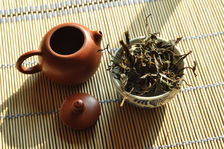
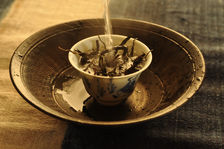
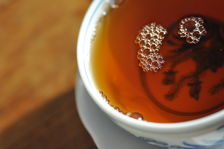
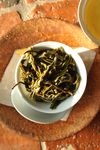
- 1. tasting tea puerh (Pu Er tea) Copyright Sébastien Vacuithé
- 2.Infusion of tea puerh (Pu Er tea) Copyright Sébastien Vacuithé
- 3.Liqueur an aged puerh (Pu Er tea) Copyright Sébastien Vacuithé
- 4.Leaves of young puerh (Pu Er tea) infused Copyright Sébastien Vacuithé
As the tasting , the amateur is the palace built gradually a reference library then it will locate and try the tea tasted it (depending on the age of the tea, region , mode of maturation , etc. ) . Qualitative judgment of tea and requires some experience and can seem difficult for beginners with missing references, but still quite accessible with a minimum of hard work and perseverance . This requires to distinguish two things, one that begins a tendency to mix the one hand the technical judgment , which tends towards objectivity, and other aesthetic , subjective and unique to each judgment.
The challenge is not in the present case by analogy to detect a particular flavor or fragrance , we find by example and with his personal sensitivity particularly charming , but to judge a number of qualitative criteria and objectives tea , such as the degree of clarity of the liquor , the presence of fat on the surface , the intensity of sensations in the mouth or throat , holding these feelings in time, the presence of tannins in the form of bitterness or astringency , etc ...
Already important for the judgment of a young tea is, it is even more important when one is interested in its potential for maturation. The aromatic character of a puerh (Pu Er tea) will indeed evolve over time , and what makes it such may be particularly attractive to your palace today may no longer be the same in 20 years, will be changed to other more mature flavors and preference of a particular flavor at a given time can not be a criterion if you think long term. Against by a tea that would present qualitative defects, missing in the database consistency , aroma , depth or richness war has chance to acquire over time , especially in the case of a natural maturation.
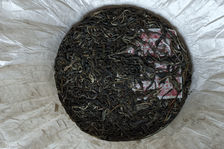
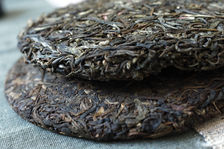
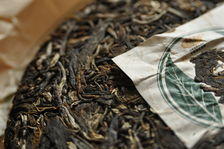
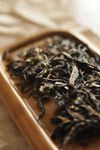
- 1.Beautiful handcrafted compressing a puerh (Pu Er tea) cake
- 2.Compression strong mechanical face a traditional compression
- 3.Leaves on the surface of a wafer Copyright Sébastien Vacuithé
- 4.Dry leaves extracted from a cake of puerh (Pu Er tea) Copyright Sébastien Vacuithé
So we begin by observing the surface of the wafer and leaves it up. The amateur will focus generally patties average compression and uniform . Cakes too little compressed (now rare ) are more difficult to maintain long-term effect , require more care and tend to go to pieces over the years , and that the patties too compressed (compression mechanical powerful ) produce a much slower maturation and thus require much more time , or a very humid atmosphere , to mature . Similarly, the lack of uniformity of the compression can also produce a lack of taste consistency over the long term , and is not preferable .
Observing the dry surface of the wafer sheets , or once those derived above , is also particularly rich in information . It read eg leaf age , ie their size , the proportion of buds or stems at the base of the leaves, the presence of different leaves of origins within the same wafer ( assembly ) sometimes or harvesting seasons , etc. , all of which have a significant influence on the evolution of tea but it would take too long to detail in the scope of this article .
Beauty leaves a dangerous notion
leaf rolling tea has two functions:All of first damage the cellular structure of the leaf to promote the extraction of its components, crucial step for the taste of tea, and give the tea leaf its specific form .
The aesthetics of the sheet having an important role in China , see sometimes predominant , some producers take great care to produce leaves in elegant and flawless appearance. If aesthetics has a significant place in the pleasure of tasting, and that care given to the beauty of the leaves is a graceful and significant refinement that brings more , it does not influence the taste of tea or its potential for maturation, and leaves may appear very crude but technically worked well can be of a very high eating quality.
The leaves that make up the ancient teas, recognized by their quality and excellent maturation have also often bein less refined than what is generally happening today aspects .
Observing liquor , dress , tea also gives information on the quality of it . Liquor quality should be pure intense and brilliant . Be wary instead of liquor that does not seem clean, dull or which are disorders , many clues that suggest a poor quality when the careful work sheets that may have an influence on the maturation of tea . We will however focus on small hairs present on some tea leaves , which can sometimes give a slight impression of disorder during the first infusion , but not in this case of bad omen. Careful observation of the liquor in this case reveals unequivocally the presence of hairs suspended , and can distinguish a failure to clear.
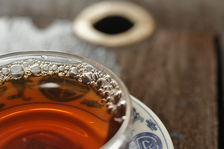
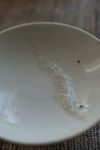
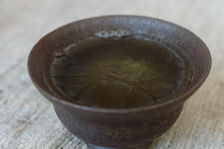
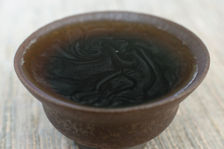
- 1. Liqueur puerh (Pu Er tea) a few years Vacuithé Copyright Sébastien
- 2.Bold tea on the lid of a gaiwan
- 3.Bold tea on the disk of a young puerh
- 4.fatty tea on a disc aged puerh
The presence of what is called fatty tea is also a sign of wealth of the sheet and a good potential when maturation . When abundant , this one is easily seen on the back cover of Gaiwan after pouring the tea, where it seems to leave some sort of foam made of bubbles . It is also observed on the disk, ie the surface of the liquor in a cup or dish pitcher , where some elements in the leaves Designed Templates in contact with air scrolls movements. Easier to perceive with fermented puerh (Pu Er tea) teas or older , who because of their color brings some of these scrolls, sometimes you play a little with light and reflections to collect these scrolls found in some young puerh (Pu Er tea) quality .
The observation infused leaves also allows interesting observations as to their quality. It allows firstly to observe the integrity of the leaves, or otherwise find that they have summer break during processing or compression. The observation sheets also reveals any burn marks on the edges of leaves , a sign of Sha Qing too long or intense and ominous when the potential for maturation tea.
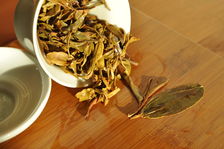
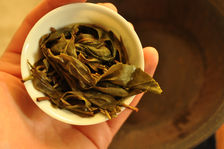
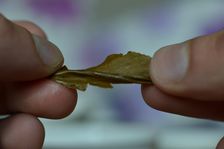
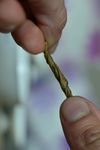
- 1. puerh (Pu Er tea) leaves infused Copyright Sébastien Vacuithé
- 2.Observation tea leaves Copyright Sébastien Vacuithé
- 3. Tensile Strength
- 4.Resistance to torsion
Finally, it is once expanded leaves that can ensure their nature ( real trees , shrubs, etc) but also their health. Take the two ends of a sheet in hand, and make minor tension and torsion makes it possible to ensure its strength. We always prefer leaves resistant and having some elasticity . Sheet rather too brittle, which tears at the slightest tension or torsion often goes hand in hand with intensive culture or assisted chemicals.
Comes naturally then perfume that leaves the tea once brewed leaves. Some see the soul of the fragrance tea, places where lies the uniqueness of his character, and the fragrance is at the center of a qualitative judgment tea . Naturally be preferred for storage of teas with flavors intense generous , and giving an impression of depth , perfumes or bland reserved. Amateur resulted go even further , and may deduct from the perfume of many experienced and flavor character of the tea. Indeed, defects in the work sheets in an improper storage while the lived almost the leaves quietly expresses through this fragrance , and some inspiration can often have a first relevant judgment on the quality of tea . Even more flavor character of tea, the way he expresses once in the mouth or throat, her outfit , ending up in its flavor and can often be estimated fairly accurately before drinking the first taste .
Such as perfumes, expected flavors of a young puerh (Pu Er tea) quality wealth and the intensity. Tea aromas generous complex , and persistent is a sign of possible future wealth, where tea whose flavors seem flat , reserved or sad war has chance to acquire this quality over time.
The tannins tea, responsible for the bitterness and the astringency also play a decisive role in the maturation of puerh (Pu Er tea) . We will therefore focus first and foremost the teas francs characters , with a bitterness or astringency marked without being excessive , having a structure capable of supporting a long maturation. As we have already noted, the tannins are not everything, and their presence must be accompanied by a rich taste to the task. So far the judgment of a young tea and tea custody and joined , it may be on the role of tannins in the balance taste they may differ.
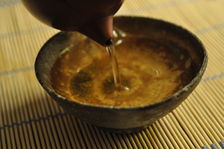
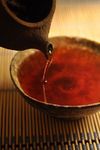
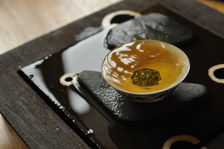
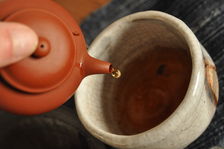
- 1.Tasting a young puerh (Pu Er tea) Copyright Sébastien Vacuithé
- 2.tasting fermented puerh (Pu Er tea) Copyright Sébastien Vacuithé
- 3.Tasting a young puerh (Pu Er tea) Copyright Sébastien Vacuithé
- 4.Tasting a puerh (Pu Er tea) aged Copyright Sébastien Vacuithé
The tannins are indeed a great role in the balanced taste of puerh (Pu Er tea) . These are the tannins that support the tasting, and give the tea strength and presence . We therefore expect a puerh (Pu Er tea) , young or old , a balanced taste that melts and forms , tannic structure and aromas , respond in a balanced and harmonious way. A lack of structure give the tea a bland and inconsistent character , while an excess of this bitterness or astringency overwrite the flavors and make the dry tasting unpleasant and aggressive. Yet these are precisely carried tannins evolve over time and will gradually lose their edge , is round and long term to the typical fluffy old puerh (Pu Er tea) emerge.
In this sense, if we can not for storage or excuse a lack of tannic structure , or a lack of aromatic richness , there may be against accepting a certain imbalance. This is the case for example of teas that are not poor aromatic level , but the flavor would be crushed by a tannic this dimension too . Such an imbalance youth leaves the potential for maturation and fear and fade and balance after a few years .
It is therefore appropriate for such teas determine when you count consuming tea (5 years ? 10 years? 25? 50? ) And ripeness desired . Some teas for example have a particularly rapid maturation are perfect for lovers of tea from 3 to 6 years of age , others are quite capable of producing in a decade of camphor aromas typical of good and very significant puerh (Pu Er tea) this age, while the other particularly tannic teas can ask for them 50 years to meet some palace.
Observe early maturation
Puerh tea evolving particularly rapidly during the first year , and observing these developments naturally gives indices are potential maturation. The color of the liquor she changed since the tea was purchased ? Is it darker or lighter rather than other teas in the same year? Tea has he changed in character over the first time we tasted and compared to other teas of the same age now in his basement ? A t evolve more or less rapidly than other teas of the same age ? Seems to balance it with time or otherwise mark imbalance? At t he kept perfume and primary aromas that defined ? A he developed secondary aromas of maturation ? In what seems to be moving towards these secondary aromas ( camphor wood , fruits) ?
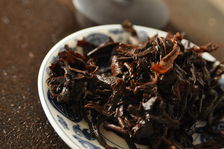
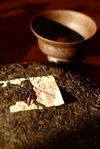
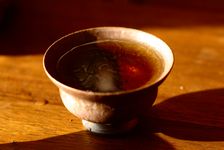
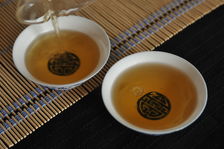
- 1.Tea Leaves 2001 Copyright Sébastien Vacuithé
- 2.Galette des 90
- 3.Liqueur a puerh (Pu Er tea) 90s
- 4.Infusion of puerh (Pu Er tea) 2 years of age Copyright Sébastien Vacuithé
It is particularly useful to be able to answer these questions to keep a book cellar , where we include in regular interval date and tasting notes so you can compare not only the character of two of its teas without having each time make a parallel, but also by comparing its past tasting notes and present to judge the evolution of the same tea over time.
We will of course take care to put into perspective the first evolution of tea with the conditions under which it was stored . Tea out of a Hong Kongers storage or naturally stored in a humid atmosphere such as Hong Kong , Taiwan or southern Yunnan naturally show a faster maturation , a darker liquor , and more pronounced secondary aromas of maturation that a tea naturally stored in a dry atmosphere. The rapid evolution of these teas in this case is related to storage conditions as much as potential tea itself , and these teas can not be compared to other teas stored in similar conditions.
Case of fermented puerh (Pu Er tea) and wet maturation
Puerh from maturation "artificial" or controlled , such as cha shu Wo Due Chinese teas or out of Hong Kongers as traditional storage continue to evolve over time , and contrary to what is sometimes thought , can have good potential for maturation .
The initial wet phase of maturation of these teas has indeed favored the multiplication and the action of naturally occurring micro -organisms in the tea leaves , producing a faster and deeper than that allows natural fermentation storage conditions . If these teas can be consumed immediately and for fermentation that appear at the output of the stock, they also benefit generally matured longer or shorter , where the initial maturation is refined , and that the micro-organisms that it will work contnueront favored fermentation .
It is preferable to light fermentations , as they were practiced in Yunnan into the 2000s, or fermented teas in traditional Hong Kongers storage . These, less fermented and thinner than contemporary shu cha, indeed leave more room for the natural maturation and are more suited to storage.
damp unfinished Storage:an economic option but risky
In traditional storage Hong Kongers , or wet storage , the tea is first exposed to high humidity over a number of years , thus promoting the growth and action of microorganisms present in tea leaves . During this period grows on the surface of various tea fungi and molds that give tea typical and unpleasant musty flavors and recall the smell of a wet basement.
In the case of a wet storage quality , this initial phase is followed by a period of said revification . During this long period of dry storage tea lose the unpleasant smell of wet storage to keep only the benefit of this one on the transformation of tea compounds action. It is only when no trace of moisture is present in the aromas of tea that can be considered complete and ready to be placed on the market.
However it takes a long time , years , and a lot of energy . Many teas sold as Hong Kongers storage are sloppy and sold too early, often just out of the wet phase and for which we merely reduce mold superficial ways passing the tea through a jet steam . These teas cheap , which is wrought the bad reputation that wet storage to non geeks, and the palace have strong traces of moisture and mold.
Generally considered poor wet storage , or cheap copies of Hong Kongers storage , some amateurs, including Taiwan see it rather unfinished and cheap wet storage , which may itself narrow low cost and leaving rest for a few years in a dry atmosphere .
If it sometimes provides access to good teas wet maturation at an affordable price this is not without risk and it is difficult, especially for those who do not have the experience to ensure the quality such a tea just out of a wet storage and still heavily stained by the latter.
Some will take before storing a quantity of these cakes , and after accelerated drying for several days , using for example a hair dryer or a fan, try to determine if the tea has a quality intrinsic , and will prove after a few years of seasoning , or if on the contrary it has been altered by moisture. But it is a risky paris reserved for professionneld or avertitd amateurs, and it is not recommended for beginners .
value of puerh (Pu Er tea) and investment , teas unequal in recovery time
Finally seeing some in storage tea economic investment and therefore seek first a valuation of teas they choose to store .
Now all teas are not equal in this and while the value of some puerh (Pu Er tea) can grow quickly , other teas are of little value , see sometimes lose their value with time. Falling prices of puerh (Pu Er tea) in 2008 and has taught many collectors , especially in Yunnan, it is not enough to store any puerh (Pu Er tea) cheap fortune.
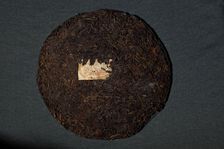
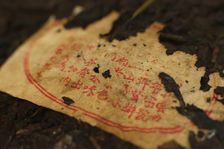
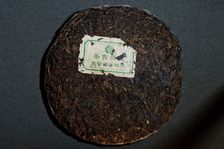
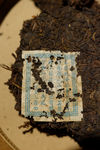
- 1. Tongqing Hao antique cake produced before 1949
- 3.Lu Yuan Fu Cha antique cake produced before 1949
- 4. Tongchang Hao antique cake produced before 1949
The wealthy amateur and has reason to bet primarily on ancient tea and other Rare teas , straddling the tea market and the antiques and having solid values and strong profit potential. The less fortunate collector will build without much risk teas older cake and the originally identified and sour produced between the 50s and the 90s, the value of these popular teas continues to grow , usually quickly.
Preference will be given to this large patties recognized , but also raw puerh (Pu Er tea) , whose value increases significantly faster than their fermented cousins, ideally from natural storage , which greatly increases their market value.
The choice of teas produced speculative purposes after the second half of the 90s is more difficult, market opening has significantly increased the available references. If the rule that predisposes raw puerh (Pu Er tea) and natural storage continues, it will take more care to choose first places teas produced by major producers recognized as Menghai Tea Factory or XiaGuan , most popular and sensitive to price increases as new unknown producers. Are also particularly sought precursors of today terroirs as raw patties Banzhang ( Bai Da Zhai ) or lesser extent Bing Dao ( Mu Shu Cha ) , the acclaimed at major competitions teas or have specially made about them in the middle of amateurs.
The collector also build on the first vintages of classic cakes became , like the first Mu Shu Cha, the first Lao Chen Sheng Hao Banzhang the 1st Da Yi Rouge, etc. , the price increases more marked than vintages following .
Whenever possible teas which increase in value following a logical and natural phenomenon , linked to the actual scarcity is preferred , supply and demand , avoiding the following teas purely speculative approaches , often short-term , such as cakes last year Da Yi despite considerable stock market value is seen to ignite a few months, but it is more epic predict the long-term rating .
Finally, the collector in Quette investment also take special care to the state of the packaging and the cake , but also the quality of its storage. These factors shape indeed greatly the economic value of tea and tea without packaging , an abyss tea or altered by storage of poor quality can easily lose up to 75 % of its value .

